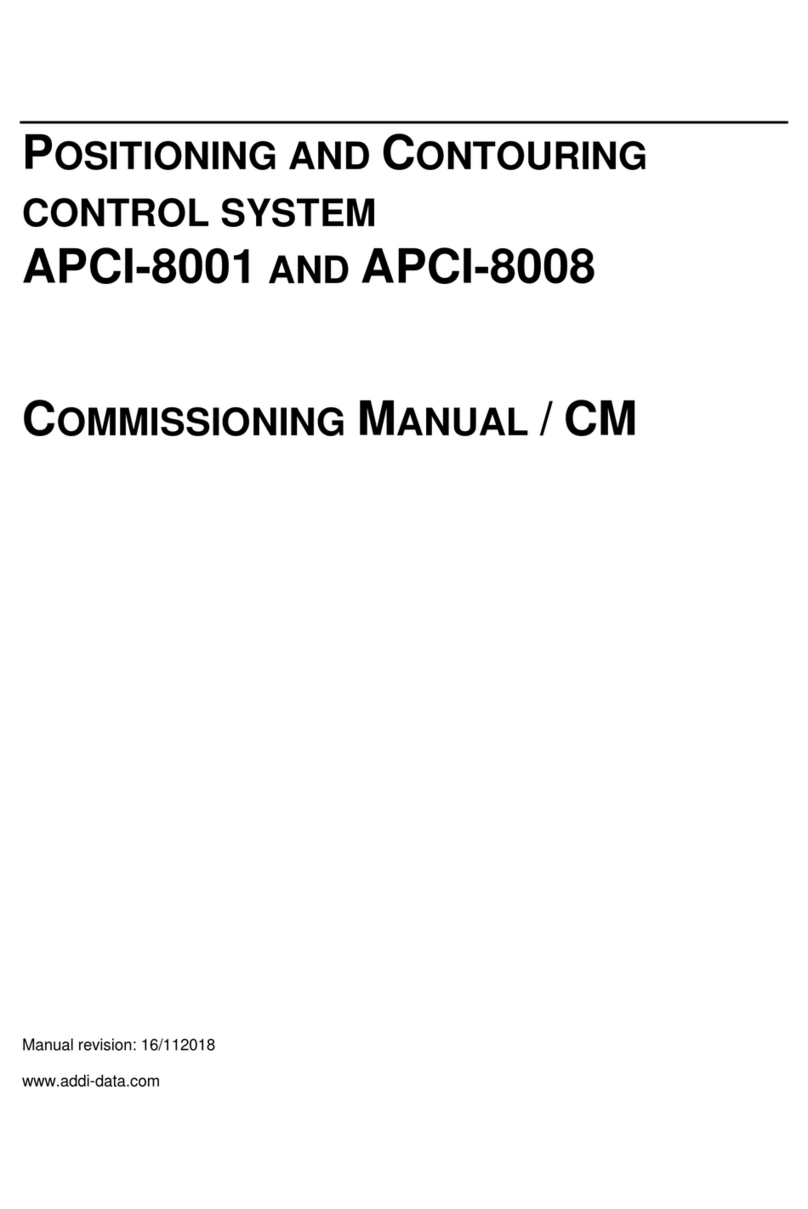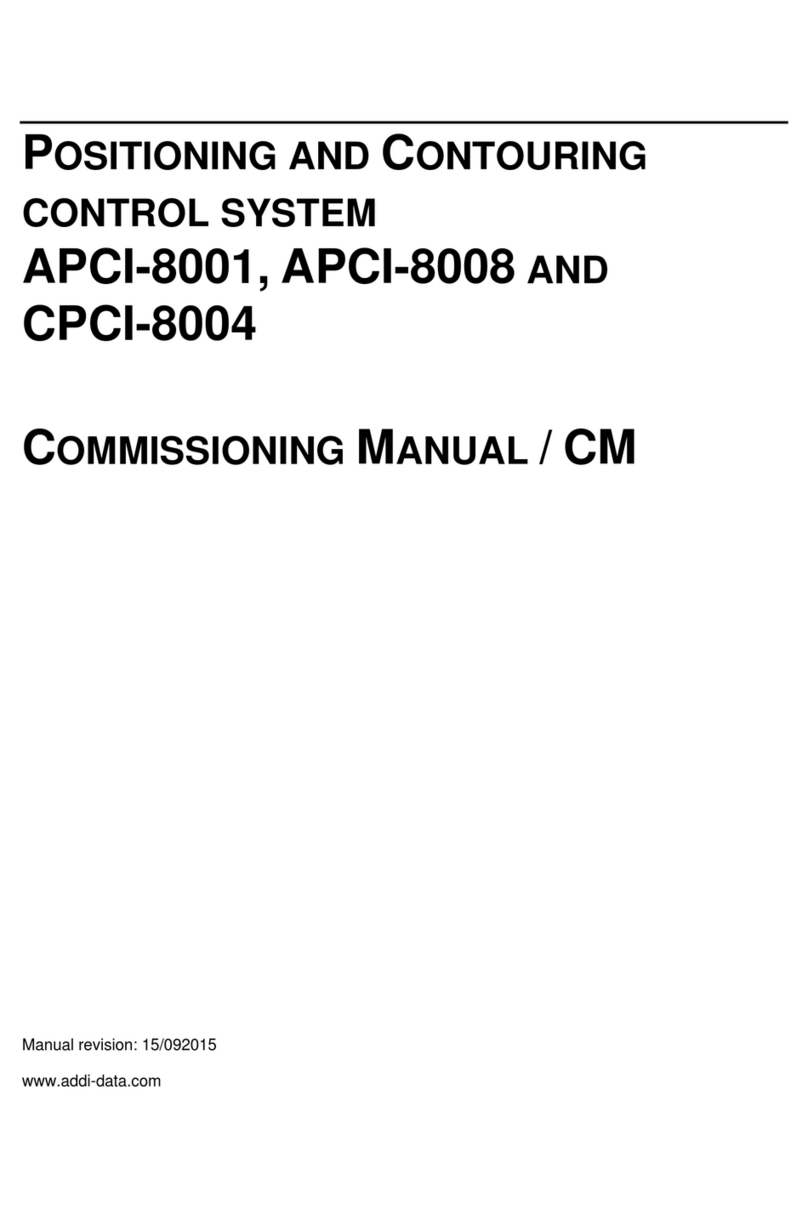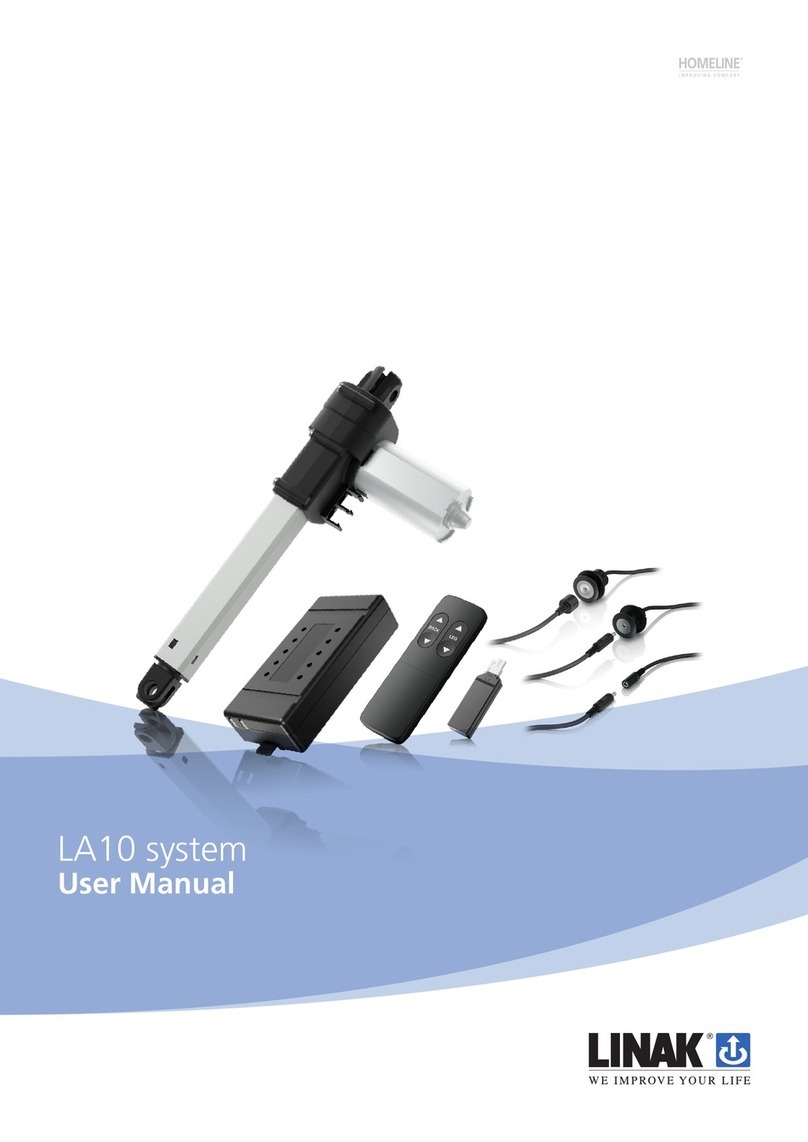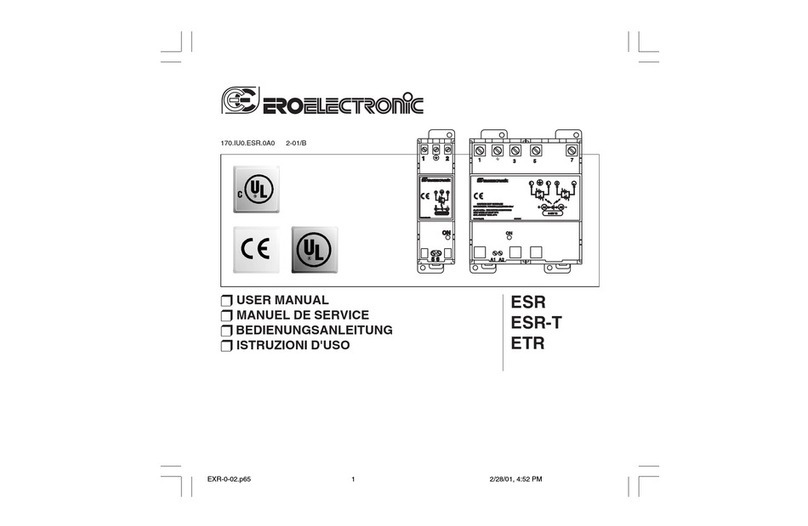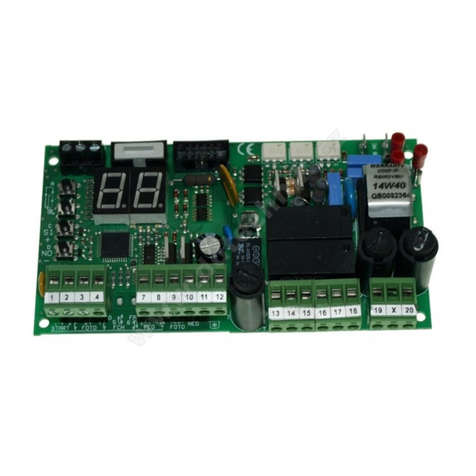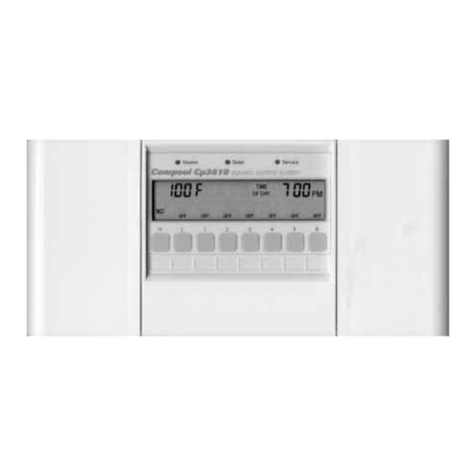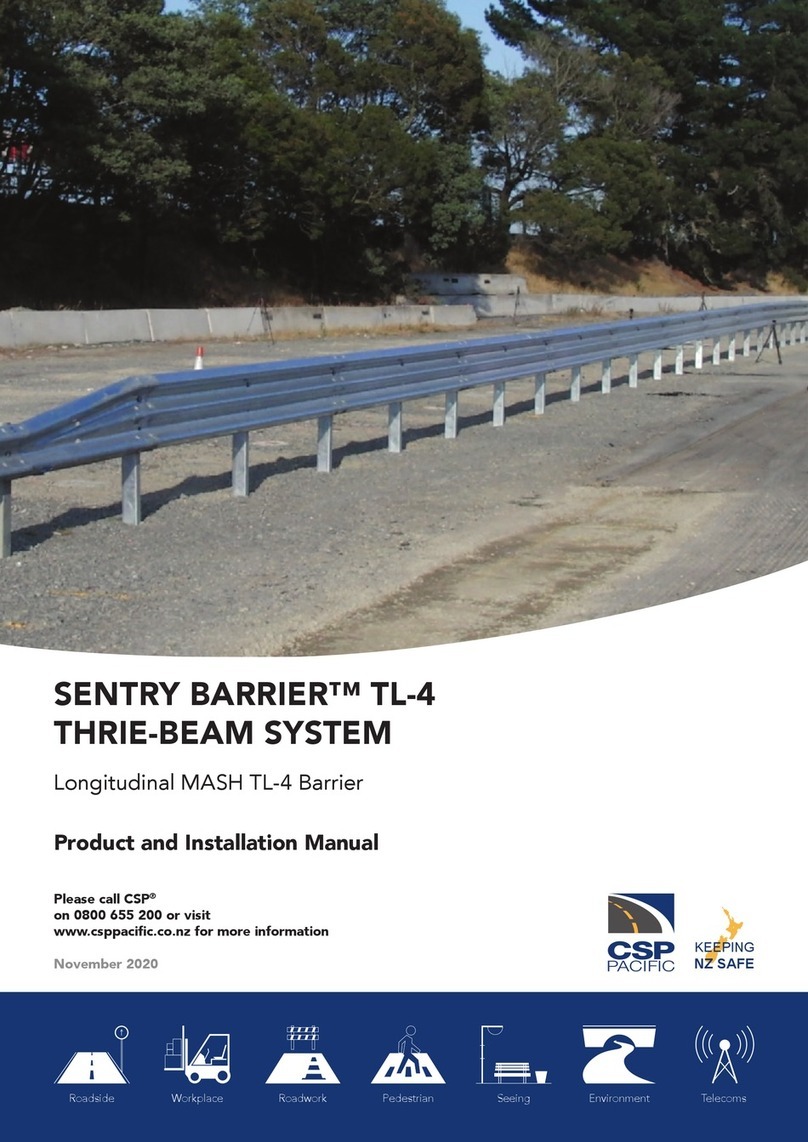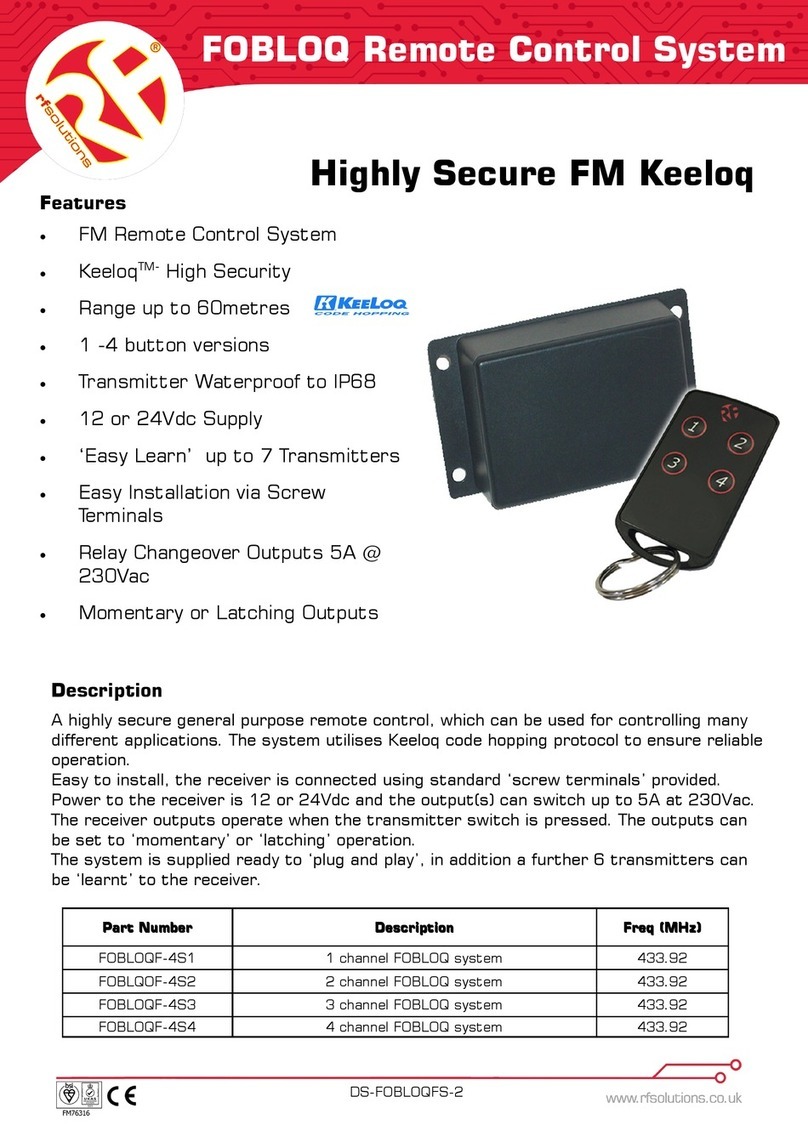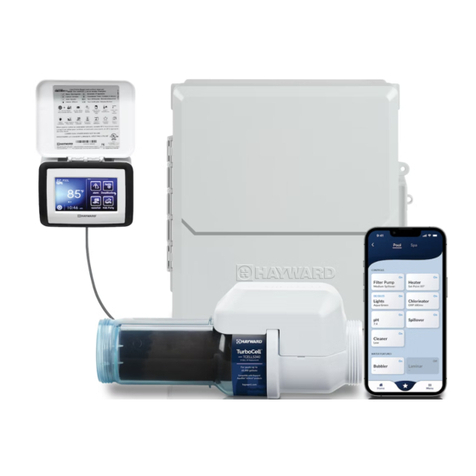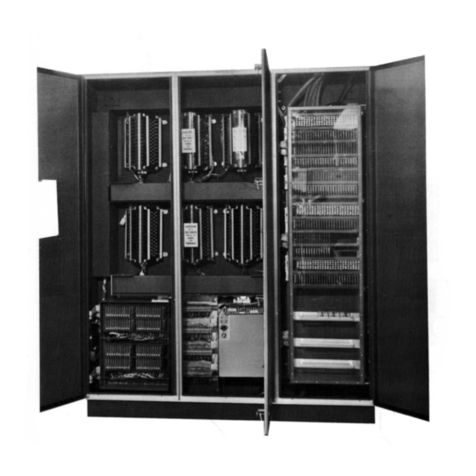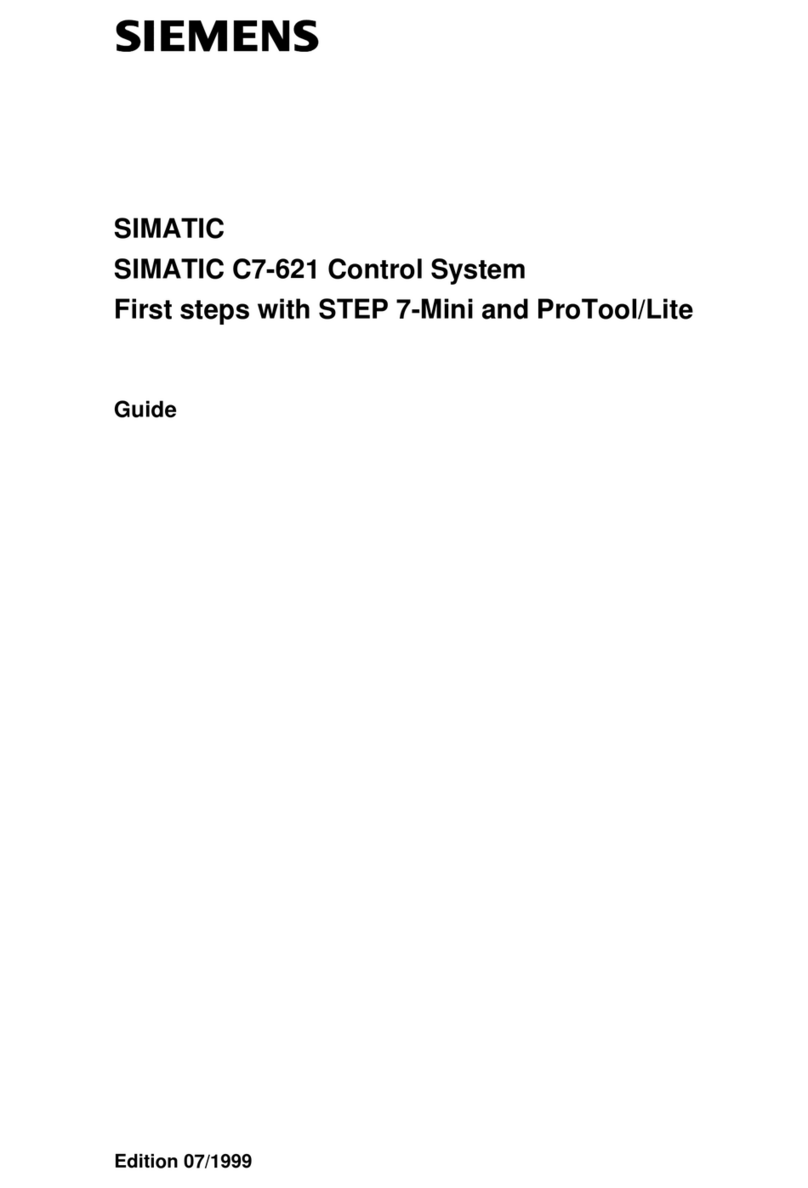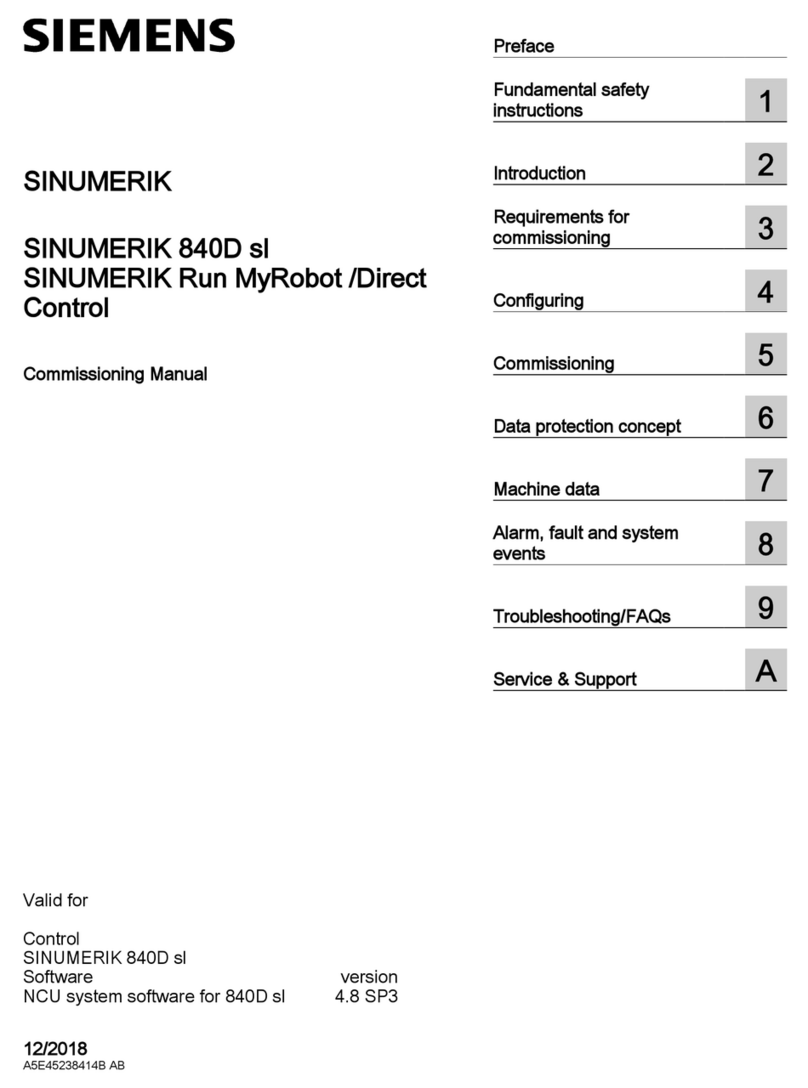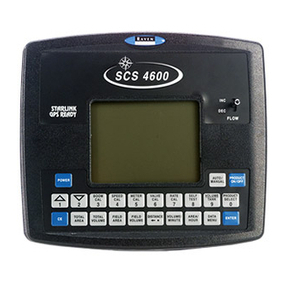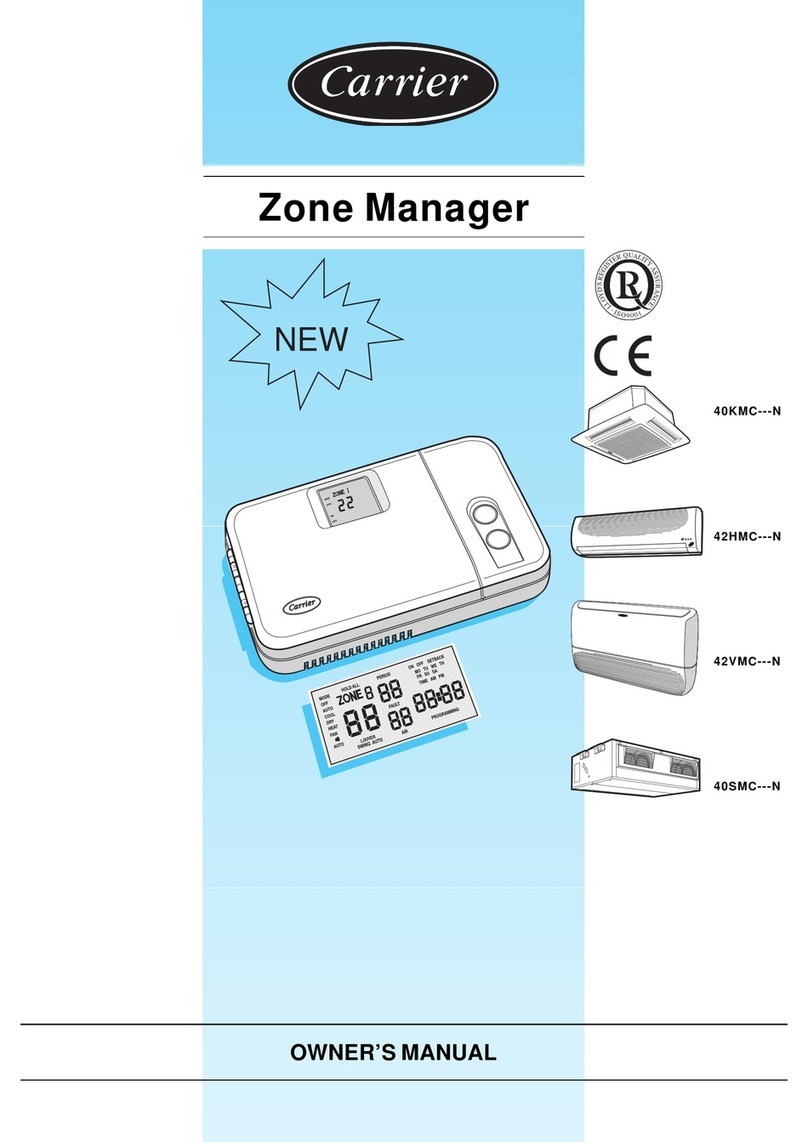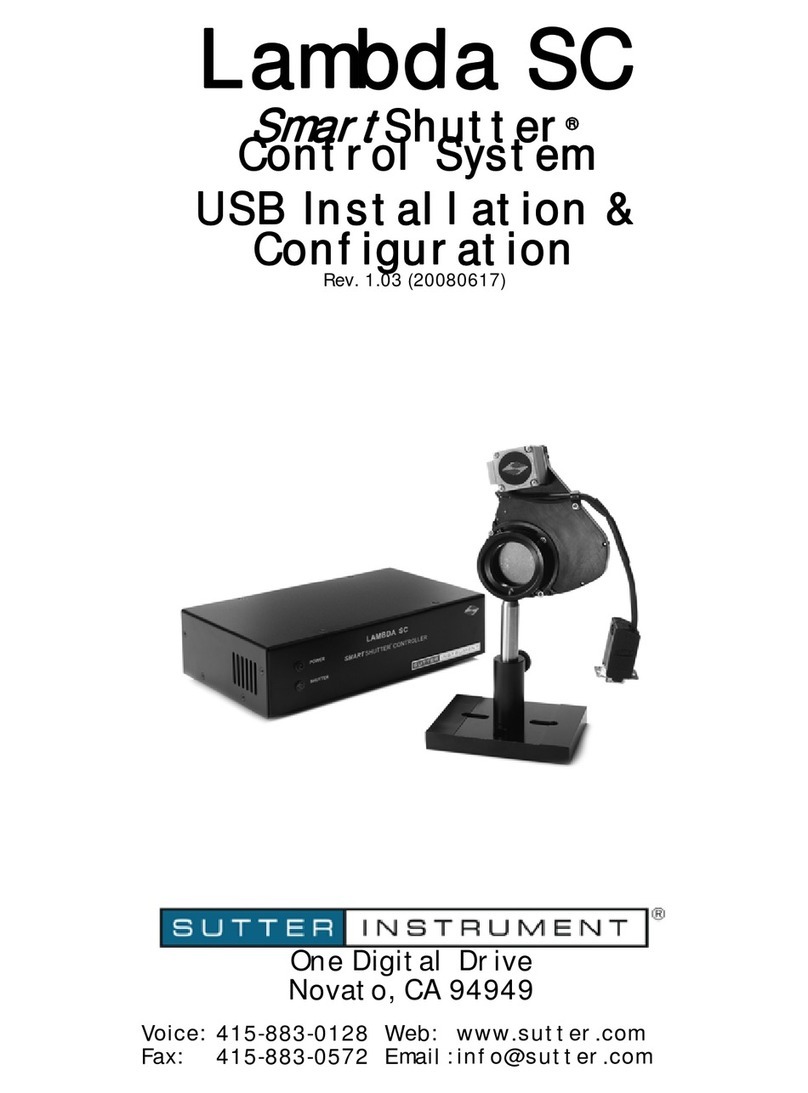Addi-Data APCI-8001 User manual

Rev. 4/112018
www.addi-data.com
POSITIONING AND CONTOURING
CONTROL SYSTEM
APCI-8001 and APCI-8008
CanBus Interface

2 Contents
1Introduction..................................................................................................................................................3
2Functions of the CanBus option................................................................................................................3
2.1Initialisation ....................................................................................................................................3
2.2Functions of the CanBus Interface ................................................................................................4
2.3Using the CAN Interface................................................................................................................5
3Using the ML71 measuring system............................................................................................................6
3.1Version notes.................................................................................................................................6
3.2Initialising the CAN module for ML71 ............................................................................................6
3.3Resources for ML71 handling........................................................................................................7
3.4The resource “ML71MeasureDataBlock”.......................................................................................7
3.4.1The “index” element of the resource “ML71MeasureDataBlock”......................................8
3.4.2The “SubIndex” element of the resource “ML71MeasureDataBlock”...............................8
3.5Note on using the “ML71MeasureDataBlock”................................................................................9

CANBUS INTERFACE 3
1 Introduction
The APCI-8001 / APCI-8008 control units can be optionally fitted with a CanBus interface. The CAN
bus is connected at connector P2. RWMOS.ELF operating system software which contains the
“optionMSM9255” option must also be used. The APCI-8001 / APCI-8008 can only act as a master
and does not have an object directory itself.
2 Functions of the CanBus option
2.1 Initialisation
Access to the CAN function is via the “universal object interface” of the APCI-8001 / APCI-8008.
The following values for the universal object interface must be applied when using the CanBus
interface.
Table 1: Object descriptor elements
Object descriptor
element Value
Handle Must be initialised with 0 when starting the application or
after rebooting the control unit and is then managed/used
by the system.
For PCAP programming: After the resource functionality
is cleaned, the handles for all elements must be reset to
zero.
BusNumber 400
DeviceNumber 8000 0000 hex index/subindex according to Table 2
or DeviceNumber according to Table 3
Index Parameters of the respective function according to
Table 2 or 3.
SubIndex Parameters of the respective function according to
Table 2 or 3.
Unless otherwise specified = 0
Further information on the object descriptor elements can be found in the document
“Universal Object Interface”.

4 CANBUS INTERFACE
2.2 Functions of the CanBus Interface
Table 2: CanBus interface functions (BusNumber 400) for DeviceNumber = 8000 0000hex:
Device
Number Name Type Explanation Index Subindex
8000 0000 Clean integer w
A
ll SAP CanBus objects are
rejected.
The parameter transferred is
meaningless.
0 0
8000 0000 StartNode integer w The node selected in Value or all
nodes (Value = 0) are started
(set to Operational Mode).
1 0
8000 0000 StopNode integer w The node selected in Value or all
nodes (Value = 0) are stopped
(set to Pre-Operational Mode).
2 0
8000 0000 EnableSync integer
r/w Sync is blocked if 0
Sync is enabled if <> 0 10 hex 0
8000 0000 SendSync integer w A sync signal is output 11 hex 0
8000 0000 ResetNode integer w The node selected in Value or all
nodes (Value = 0) is/are reset
(set to Initialisation Mode).
81 hex 0
8000 0000 CanBus
Enable integer w The CanBus function is enabled
if a parameter <> 0 or blocked if
parameter = 0.
100 hex 0
8000 0000 CanBus
Open integer
r/w The CanBus is opened.
This call is required once per
system boot or after a CanBus
Close.
101 hex 0
8000 0000 CanBus
Close integer w The CanBus is closed.
102 hex 0
8000 0000 CanBusInit integer w The CanBus is initialised.
This call is required at least after
every CanBusOpen.
If the parameter is 500, a baud
rate of 500 kbits/s can be set.
(Default: 1 Mbit/s)
103 hex 0
8000 0000 CanBusStart integer w The CanBus is started.
With this command, the CAN bus
controller of the APCI-8001 /
APCI-8008 is started.
104 hex 0
8000 0000 CanBusStop integer w The CanBus is stopped.
With this command, the CAN bus
controller of the APCI-8001 /
APCI-8008 is stopped.
105 hex 0

CANBUS INTERFACE 5
Table 3: CanBus interface functions (BusNumber 400) for DeviceNumber not equal to 8000 0000hex:
Device
Number Name Type Explanation Index Subindex
600h PP_FC_SDO_
RX integer
r/w Read and write access to the
service data objects of CAN
subscribers
Can
Index Can
Subindex
200h PP_FC_PDO1_
RX integer
w Describe process for
data channel 1 Number of
bytes
300h PP_FC_PDO2_
RX integer
w Describe process for
data channel 2 Number of
bytes
400h PP_FC_PDO3_
RX integer
w Describe process for
data channel 3 Number of
bytes
500h PP_FC_PDO4_
RX integer
w Describe process for
data channel 4 Number of
bytes
The DeviceNumber represents the CAN identifier. The node number (Node-Id) of the device to be
addressed must be additionally specified in the least significant 7 bits of the DeviceNumber. If Node-Id
is 0, all nodes are addressed.
This list can be extended for the specific user. The driver level remains unaffected by customised
extensions. Only the RWMOS.ELF operating system file must be updated.
2.3 Using the CAN Interface
•Run CanBus Clean at program start so that any existing access objects are deleted.
•Request CanBusOpen; if not “true”, then assign 1 to each of the variables “CanBusOpen”,
“CanBusInit” and “CanBusStart”
•Enable CanBus function in RWMOS by calling the “CanBusEnable” function with the
parameter 1; only then are accesses via the CanBus possible
•Reset one or all of the CAN subscribers with the command “ResetNode”.
The NodeID is specified in the parameter. A value of 0 means all CAN subscribers are
addressed. Each subscriber sends a message: 700hex + NodeID and a data byte with the
value 0.
•Start nodes with the command “CanNodeStart”.
Note: After a ResetNode, a node must first be registered with RWMOS.ELF before it can
be started. Where this is not the case, accessing “CanNodeStart” returns the value 1. This
may involve a waiting time (possibly of several seconds).

6 CANBUS INTERFACE
3 Using the ML71 measuring system
When using the ML71 measuring system from Hottinger Baldwin Messtechnik GmbH, an
implementation exists for recording measuring values via a CAN interface. Measuring values are
handled using the resource interface of the APCI-8001 / APCI-8008.
The measuring values are transferred to the APCI-8001 / APCI-8008 via the CAN bus. When using
CAN-Bus 1 of the ML71, the measuring values can be processed individually or line by line
(resource # 10000) or, in conjunction with the scanner functionality, block by block (resource #
10013).
When using CAN-Bus 2 of the ML71, only line-by-line processing can be carried out, since the
measuring values are not acknowledged via a sync signal here.
3.1 Version notes
The RWMOS.ELF operating system software must include the options “optionMSM9255”
(CAN support), “optionRESOURCE” and “optionML71” in order to use the function of the ML71
module. This version is only available from V2.5.3.72.
3.2 Initialising the CAN module for ML71
The information in Section 2 sometimes applies here. However, the ML71 measuring system does not
support the CANopen protocol. Thus, only the following operations are necessary and permitted for
the initialisation and commissioning of the CAN bus.
•Run CanBus Clean at program start so that any existing access objects are deleted.
•Request CanBusOpen; if not “true”, then assign 1 to each of the variables “CanBusOpen”,
“CanBusInit” and “CanBusStart”
•Enable the CanBus function in RWMOS by calling the “CanBusEnable” function with the
parameter 1; only then are accesses via the CanBus possible
•Read the measuring values using resource # 10000 or using resource numbers 10000 or
10013 in the scanner module (see Table 4).

CANBUS INTERFACE 7
3.3 Resources for ML71 handling
Table 4: List of device numbers for ML71 handling
Dev.# Name Type Explanation Parameter index
[Subindex]
10000 ML71
Measure
Value
integer
single
short int
Measuring value of an ML71
measuring system
(data type depending on measuring
system settings)
Index of the measuring
value channel
(0..127)
10001 ML71
Status integer r Bit-coded status word according to
Table 5
10013 ML71
Measure
Data
Block
datablock r All measuring values accumulated by
an ML71 measuring system as a
data block for scanning (data type
depending on measuring system
settings)
Number of measuring
values per record (columns)
[Max. number of records
(lines)]
The resource 10013 can only be used to record measuring values via the scanner interface. However,
even with this resource, a read request must first be performed via the resource interface in order to
obtain a valid handle. This read request must be successfully called using the “rdOptionInt” function
(see “Universal Object Interface" manual, Section 2.1.2.1). The number of measuring value lines
already received via CanBus is returned in the “val” parameter. Using this value, it can be seen
whether the data transfer via CAN bus is ready.
3.4 The resource “ML71MeasureDataBlock”
There are two options for recording the measuring values received via CAN bus using the scanner
module. In the first instance, the resources “ML71MeasureValue” can be integrated in the scan record.
In this case, the most recently updated measuring value is read by the scanner. This option is
available when using CAN-Bus 1 and CAN-Bus 2 of the ML71.
When using CAN-Bus 1 of the ML71, it is also possible to use the resource “ML71MeasureDataBlock”
as the scan object. In this case, all the measuring values accumulated since the last scan time are
entered in a data block of a fixed size. It is, therefore, possible to record all measuring values without
any gaps.
The scanner is programmed in the same way as for scanning a position value, for example.
The special feature of this resource, however, is the layout of the data block recorded, which itself
represents a data structure (record). This data structure has the following layout:
Integer
number Integer
status
integer
lines integer
columns
Line 0: Integer or float
Measuring value 1 Integer or float
Measuring value 2
... Integer or float
Measuring value m (128 max.)
Line 1: Integer or float
Measuring value 1 Integer or float
Measuring value 2
... Integer or float
Measuring value m (128 max.)
....
Line n: Integer or float
Measuring value 1
(n = maximum 16)
Integer or float
Measuring value 2
... Integer or float
Measuring value m (128 max.)

8 CANBUS INTERFACE
The size of the data block in a scan is always fixed. The number of lines in this data structure (zn) is
specified in the object descriptor element “Index” in the less significant 16 bits. The number of
columns (an) is specified in the object descriptor element “SubIndex”. The content of “Index” and
“SubIndex” is described in more detail below.
The number of elements containing valid measuring values may vary from scan element to scan
element and is specified in the first element of the data structure (“Number”).
The second element in the data block (“Status”) is bit-coded and shows, for example, a possible data
overrun. The meaning of this register is described in Table 5.
The “Lines” element specifies how many lines have been written on with measuring values in the
current block. The “Columns” element specifies how many columns have been written on with
measuring values in the current block. The table with the measuring value follows this. A table
element always has a word length of 32 bits. The content of the table elements is derived from the
ML71 settings and is not specified by RWMOS.ELF. Here, the data formats 32-bit floating point
number,
32-bit integer and 16-bit integer are possible.
Table 5: Bit-coding status word in the “ML71MeasureDataBlock”
Bit No. Name Function
0 Currently not used
1 Currently not used
2 Data
Overrun
A
data overrun has taken place; not all data
received could be read.
3 Size
Change The number of measuring values in one measuring
value line has changed.
4 LineErr The number of data lines in DataBlock is not
sufficient.
5 ColErr The number of measuring values in one data line
in DataBlock is not sufficient (too few columns
defined).
3.4.1 The “index” element of the resource “ML71MeasureDataBlock”
Information on the size of the measuring value data block is specified in this element. “Index” must
contain the number of measuring values to be recorded in one line as a numerical value (128 max.).
This is the number of columns in the measuring value table.
3.4.2 The “SubIndex” element of the resource “ML71MeasureDataBlock”
The number of lines with measuring value data in the data structure described above is specified in
the “Subindex” element (16 max). The number of lines actually written on by RWMOS.ELF is
displayed in the 3rd element of the “Lines” data structure.
The size of the scan record is specified by the values entered in “Index” and “SubIndex”. To avoid
unnecessary memory requirements in the scanner record and unnecessary data transfer, these
values should not be set any higher than necessary.

CANBUS INTERFACE 9
3.5 Note on using the “ML71MeasureDataBlock”
Recording data and transferring the recorded real-time data into the scanner requires computing time
in the real-time task of RWMOS.ELF. For this reason, the sampling time should, where possible, not
be set to below the default value of 1.28 ms. Further information on this can be found in the
Commissioning Manual (CM) under the key word “SampleTime”.
The “ML71MeasureDataBlock” module is used according to the following scheme:
•Initialisation of the CAN module (see Chapter 3.2)
•Initialisation of and read access to the resource “ML71MeasureDataBlock”
•Initialisation of the scanner using the resource “ML71MeasureDataBlock”
•Performance of the scan with the scanner module (as normal).
Other manuals for APCI-8001
2
This manual suits for next models
1
Table of contents
Other Addi-Data Control System manuals
